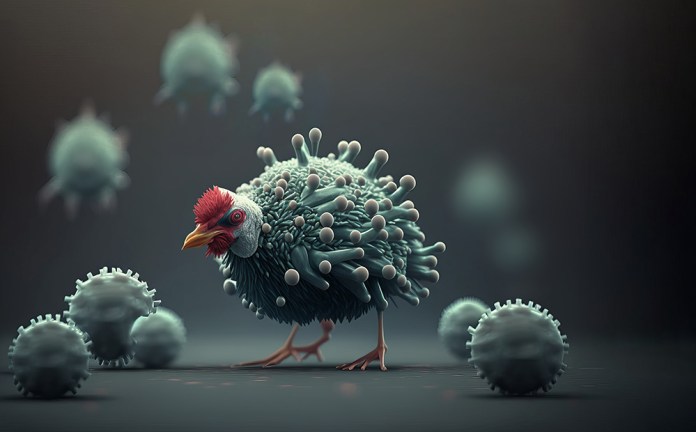Is the UK prepared for a potential bird flu epidemic among humans? The answer is no, says influenza virologist and lecturer, Dr Nicole Robb.
The odds of a bird – or avian – flu outbreak in people are low, with no sustained cases of human-to-to human transmission to date.
But that doesn’t mean it couldn’t happen and we should be prepared for the worst-case scenario, warns Dr Robb. There have been six major pandemics over the last century, and frequency of outbreaks has accelerated significantly over the last 20 years.
Currently, levels of H5N1 in birds in the UK are unseasonably high and H5N1 2.3.4.4b has also been detected in mammals such as foxes and otters. Add the ominous fact that previous cases of bird to human transmission are associated with high fatality rates of over 50 per cent, and it’s small wonder that Dr Robb is pushing for advanced diagnostic testing.
Dr Robb is Assistant Professor at Warwick University, an Oxford University lecturer, and co-founder of healthtech company Pictura Bio. She leads a team at Warwick University focused on improving diagnostics for the H5N1 virus in both birds and humans. Together with Oxford University scientist, Nicolas Shiaelis at Pictura Bio, the aim is to accelerate diagnostic technology and propel it to the frontline of healthcare.
Pictura Bio uses artificial intelligence which is trained to recognise all known pathogens, including flu viruses and their different strains. This technology can already detect human strains of influenza and Dr Robb and her team are working to develop this capability further so that it can identify new strains of the H5N1 virus using AI facial recognition within minutes
Why is Avian flu such a serious threat? Dr Robb explains: “H5N1 viruses do not currently have the ability to easily infect the human upper respiratory tract, and therefore usually do not spread from human to human. However, the recent global spread of avian H5N1 viruses amongst birds and its detection in multiple mammalian species have raised concerns about its ability to potentially adapt to spread between humans and cause a pandemic. If this occurred, the virus could pose a significant danger to the population due to the high mortality rate associated with human infection.
“As the global population grows, humans are moving into previously uninhabited areas, meaning more humans come into contact with wildlife which increases the risk. Whether it’s H5N1 or a different virus, it is inevitable that new viruses will continue to emerge and threaten another pandemic.”
She also underlines the fact that the virus is no longer seasonal, with none of the usual lull in spring and summer cases. “Influenza outbreaks often occur during months when temperatures are relatively cool. However last year we didn’t see the typical decrease in cases that would normally occur during summer months, driven by the higher-than-normal circulation levels of these viruses.”
Dr Robb says it’s impossible to predict when the next influenza pandemic will occur or what virus will cause it. She adds: “H5N1 is primarily a disease of birds and the risk to the general public is low, but the more the virus circulates in birds, the more opportunities it has to spill over into animals or humans, and the higher the chance of the virus adapting for human spread. We therefore urgently need constant vigilance and ongoing surveillance for novel influenza viruses worldwide, in both people and animals, to prevent another pandemic.
“The good news is, unlike when COVID-19 emerged, H5N1 has been around for 20 years so we already have tests and vaccines. However, none of this is available at scale.
“It is essential to have reliable, quick diagnostic testing readily available in the community. It took far too long to get community testing up and running with COVID which enabled the virus to spread. COVID could have had much less of an impact if we had rapid community testing from the start.”
Dr Robb believes that technology and artificial intelligence are key to this improved testing, as outlined in a recent peer reviewed paper published in ACS Nano on a study with the John Radcliffe hospital.
“During the Covid pandemic it took months to put widespread public testing into place. We now need to invest in upcoming diagnostic technology that could make this process more efficient and quicker in the event of a new outbreak.
“For example, we have technology – like the AI based Pictura Bio platform – that can decentralise diagnostic testing, take it out of a laboratory and bring it into the community where it can be quickly and easily accessible to the public. This means that in the worst-case scenario of a new pandemic, testing could be available in days/weeks rather than months.
She adds: “If Avian flu begins to spread more widely, this technology will provide results much more quickly. It will also give people the power to test themselves at home and relieve the strain on medics and our healthcare system. However, we need investment in the UK’s testing infrastructure to speed up this process.”
Even without human transmission of H5N1, the devastating threat of bird flu looms over the global poultry industry, and the message has already hit home. Dr Robb acknowledges that government agencies like Defra, the Animal and Plant Health Agency, and the UK Health Security Agency are “rightly taking this very seriously.”
But while there is no evidence that HN1 presents an imminent threat or can spread between people, she stresses there can be “no room for complacency.”
More about Pictura Bio’s work here.

















